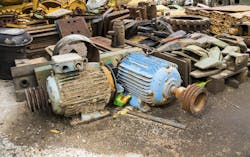Protecting 3-Phase Motors from Voltage Imbalance
Having both 3-phase and single-phase loads can be challenging when trying to balance the voltages at a facility. It’s possible that during a facilities operation, one phase can be lightly loaded during a period of time and heavily loaded at a different period of time, causing the voltage differences between phases to increase. Adding to this issue are the voltage imbalances that exist on the electric utility circuit as its feeding commercial, industrial, and single-phase residential loads. This unbalanced voltage is detrimental to 3-phase motors because it causes the motor to draw in an unbalanced current. The overall result of this imbalance is an increase in motor temperature.
There are a few ways to protect a motor against voltage imbalance. One consideration is to balance the electrical load on all three phases at the facility. Reconfiguring the single-phase circuits will support in balancing the voltages.
The second consideration is to lessen the motor load during operation. This will reduce the current drawn by the motor and lower the motor temperature. This is understandably not practical for some facilities but may be an option for others.
The third consideration is to install a 3-phase voltage and current monitoring device near the terminal of the motor that requires protection. These devices are configurable and can output a signal to the motor’s contact to open, and thus disengage the motor from the circuit. This device can also protect against phase losses that may occur upstream of the motor.
Lastly, installing a motor drive offers the same features as the 3-phase monitoring device, but also shields the motor from the voltage imbalances. The drive has a higher tolerance to voltage imbalances and can run a motor without it being severely de-rated. However, a motor drive can be costly and, depending on the size of the motor that it’s driving, it may require additional equipment to reduce harmonic emissions.
“ANSI/NEMA MG 1-2016 Motors and Generators” identifies the recommended deration values for various types of motors.
